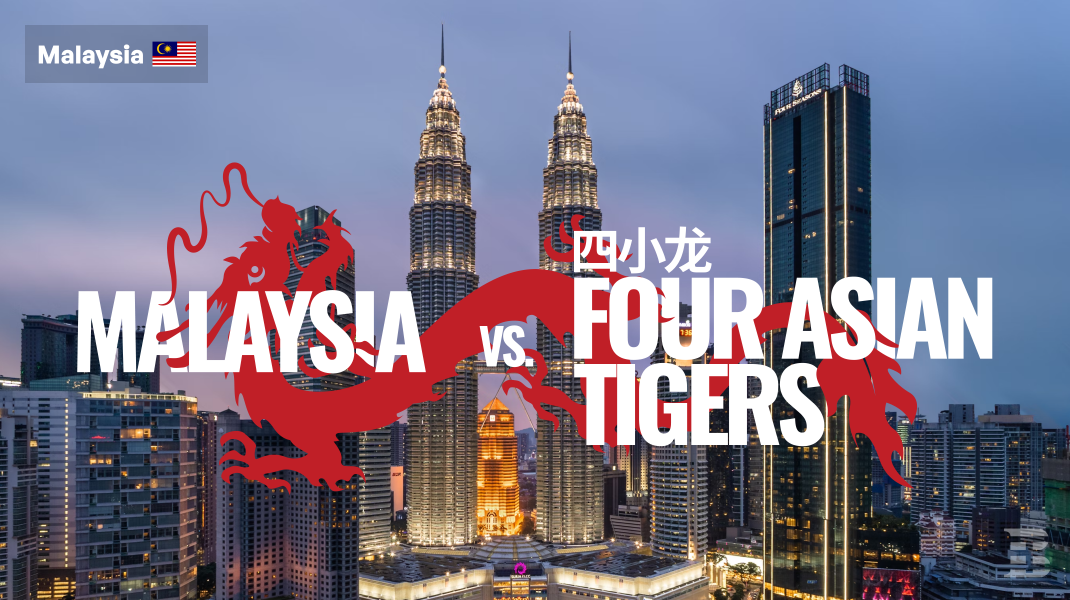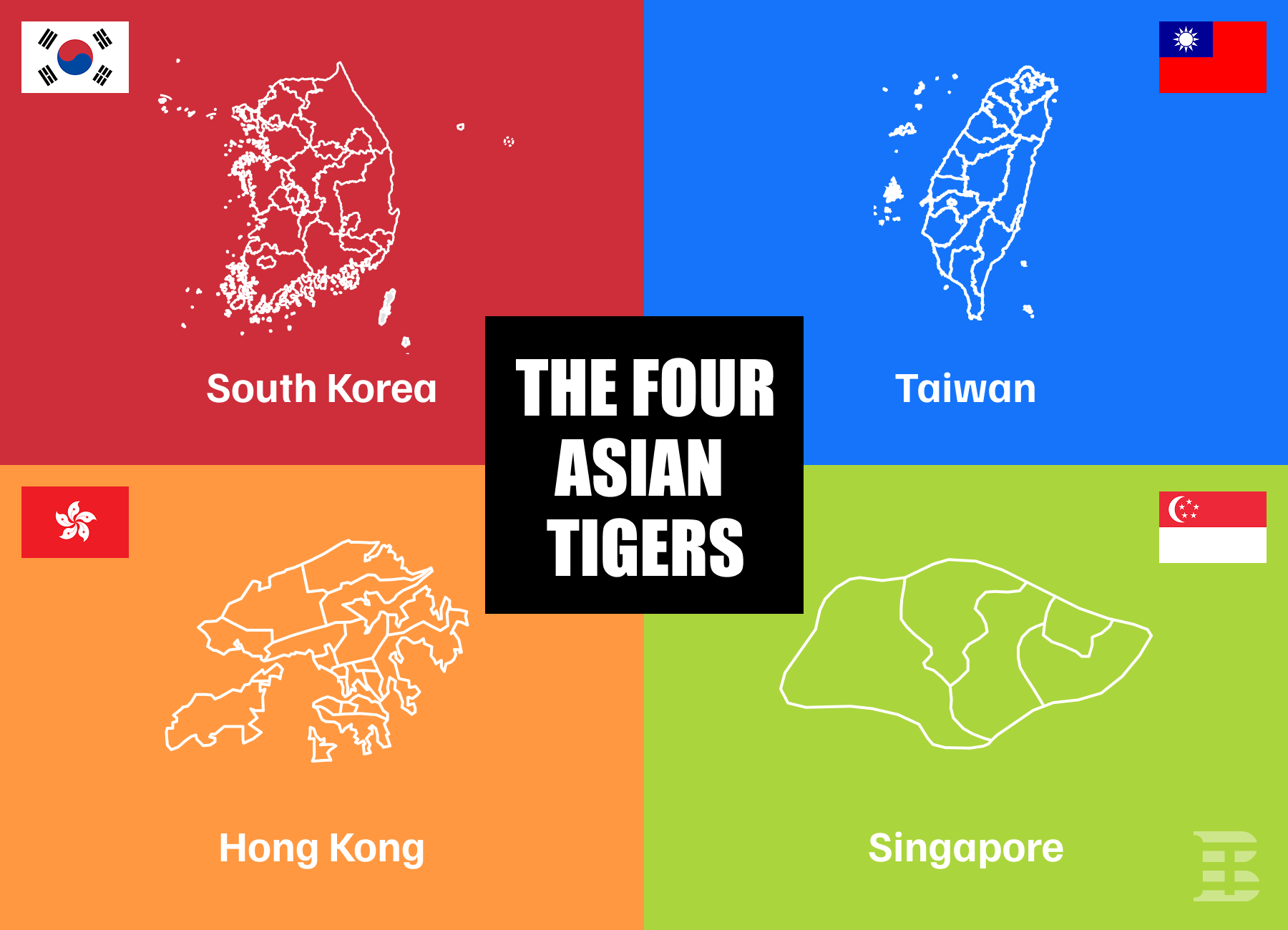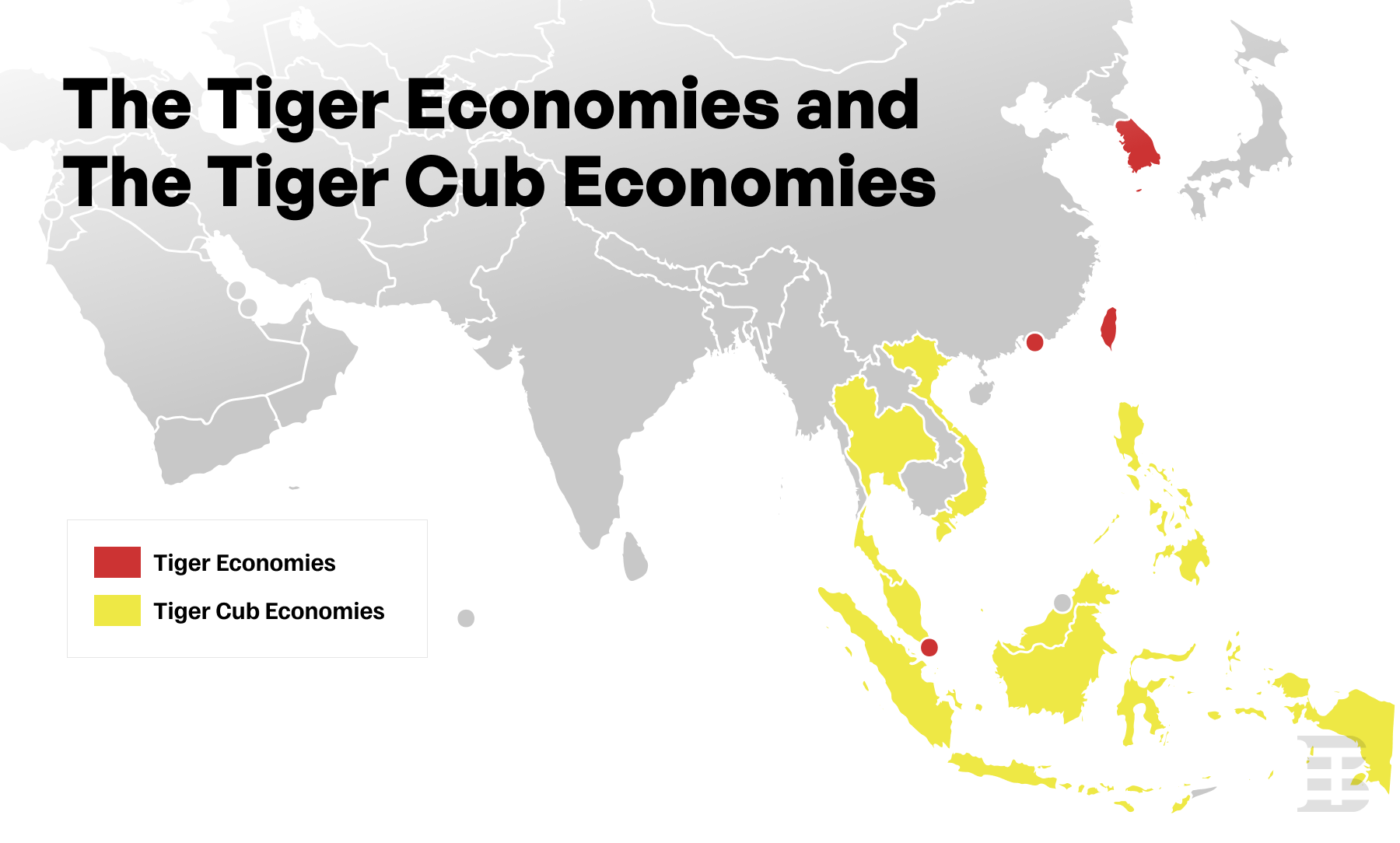Malaysia vs Four Asian Tigers - Aspiration for Economic Success

The Four Asian Tigers - Hong Kong, Singapore, South Korea, and Taiwan are represented as the pioneers of rapid economic transformation and fortitude.
These economies share a familiar path of rapid industrialization, export-driven growth, and strategic policy making.
Malaysia, known for its abundant potential and resources, offers an interesting contrast to the Tigers’ narrative.

Who Are The Four Asian Tigers?
The Four Asian Tigers (also the Four Asian Dragons or Four Little Dragons in Chinese and Korean) refer to the economies of Hong Kong, Singapore, South Korea, and Taiwan.
Between the 1950s and 1960s, they went through rapid industrialization and adopted an export-oriented policy. This allowed them to keep high rates of growth, more than 7% a year.
At the start of the 21st century, the economies of the Four Asian Tigers developed into high-income economies, specializing in different fields. For example:
- Hong Kong and Singapore became leaders in international finance hubs.
- South Korea and Taiwan have become manufacturing leaders, particularly in electronics and automobiles.
| Country | Population (millions) | GDP Nominal (trillions USD) | GDP Nominal per Capita (USD) | GDP (PPP trillions USD) | GDP (PPP per Capita USD) |
|---|---|---|---|---|---|
| South Korea | 51,75 | 2,00 | 38,64 | 2,50 | 48,35 |
| Taiwan | 23,57 | 0,85 | 36,06 | 1,20 | 50,93 |
| Hong Kong | 7,50 | 0,40 | 53,33 | 0,50 | 66,67 |
| Singapore | 5,70 | 0,45 | 78,95 | 0,60 | 105,26 |
This drastic economic growth is often used as an example for many developing countries, particularly for the Tiger Cub Economies of Southeast Asia. They are known as the economies of still-developing countries of Indonesia, the Philippines, Thailand, Vietnam, and Malaysia.

|
Rank |
Country |
Population in millions |
GDP Nominal trillions of USD |
GDP Nominal per capita thousands of USD |
GDP (PPP) trillions of USD |
GDP (PPP) per capita ← thousands of USD |
|---|---|---|---|---|---|---|
|
ー |
ASEAN |
685.15 |
4.16 |
6.07 |
11.93 |
17.41 |
|
1 |
Indonesia |
279.96 |
1.54 |
5.51 |
5.51 |
16.84 |
|
2 |
Thailand |
70.27 |
0.543 |
7.73 |
1.67 |
23.71 |
|
3 |
Philippines |
114.16 |
0.476 |
4.17 |
1.38 |
12.13 |
|
4 |
Vietnam |
101.3 |
0.469 |
4.64 |
1.55 |
15.32 |
|
5 |
Malaysia |
33.460 |
0.465 |
13.91 |
1.31 |
39.07 |
Strategies for Economic Growth
While the Tigers’ export-oriented model uses industrialization and global competitiveness, Malaysia’s resource-powered strategy showcases the benefits of investing in natural wealth for economic stability, showing two different paths to growth.
The Four Tigers Export-Oriented Policy versus Malaysia’s Resource-driven Approach
The Four Tigers
The first economy to undergo industrialization was Hong Kong, with the growth of the textile industry in the 1950s. By the 1960s, manufacturing included more sectors like electronics, clothing, and plastics for export. Singapore adopted national economic measures to boost the country’s manufacturing industry.
In the meantime, Taiwan and South Korea began industrialization in the mid-1960s with strong support from the government. Both countries were seeking export-oriented industries, such as Hong Kong and Singapore. These countries took an example from Japan’s rapid success and tried to repeat its tactic. To invest in the same fields: education and infrastructure.
By the end of the 1960s, the levels of human and physical capital of the Four Tigers were above those of other countries with the same level of development, and it led to the growth of human capital income.
Besides investments, education was a major factor in the growth of the Four Asian Tigers before the 1997 economic crisis. The four nations achieved universal primary education by 1965. South Korea reached an 88% rate of secondary education enrollment by 1987. In addition, the gap between female and male enrollments was decreasing. All these factors ensured that the education of the Tigers provided a high level of education and cognitive abilities.
The main reason for the Four Tigers' economic rise is their export policy; however, the four nations took different approaches.
- Hong Kong and Singapore adopted free trade regimes;
- South Korea and Taiwan used mixed strategies, such as export incentives and targeted support for specific industries.
These measurements assure that the Tigers managed to sustain a 7,5% annual growth during three decades, transitioning the Four Tigers to the status of developed countries.
Malaysia
Malaysia is a Southeast Asian country. It is known now as one of the five Tiger Cubs, but Malaysia was on the path to becoming the fifth Asian Tiger. It couldn't reach that level due to an economic crisis in 1997 in Asia. In the present day, Malaysia is seemingly on the upward curve again.
When it gained its independence in 1963, Malaysia’s economy was dependent on its strategic location and natural resources such as oil and natural gas, large tin, palm, and rubber trees.
Malaysia’s economy was heavily dependent on these natural resources and agriculture, which didn’t primarily benefit the local population. The volatility of the natural resources price and the rising popularity of synthetic alternatives, like synthetic rubber. These reasons further weakened industries like rubber production, leading to unemployment and poverty. By the 1970s, Malaysia moved its focus to a third-sector-powered economy, emphasizing industrialization and manufacturing.
“It became very clear that manufacturing, in particular, was really the key to industrialization; commodity dependence was perpetuating underdevelopment,” Volz told World Finance.
Malaysia started to repeat the tactic used by the Tigers, basing its economy on manufacturing starting in the 1980s. External funds, such as significant support from Japan, played an important role. As a result, Malaysia achieved economic growth, keeping a GDP growth rate of 7% through the 1980s and 1990s. This is an impressive result for a nation recovering from decades of colonization.
Role of Government Policies
The role of government policies in shaping economies is significantly different between the Tigers’ private sector-driven approach and Malaysia’s New Economic Policy (NEP).
The Four Tigers’ private sector-driven approach
The Asian Tigers (Hong Kong, Singapore, South Korea, and Taiwan) centered their focus on export-oriented industrialization and depended heavily on private sector initiatives. The Governments of these countries played a crucial role by creating a beneficial environment for business. For instance, they invested in infrastructure, education, and technology.
The four governments wanted their countries to benefit from skilled workers with high-level jobs, for example, doctors and engineers. That is why they focused on investing heavily in education, besides infrastructure. The Four Asian Tigers became global study hubs, and several universities from these nations are in the “QS World University Rankings 2024: Top global universities.”
- Hong Kong, the Hong Kong University of Science and Technology, and The University of Hong Kong;
- Singapore, National University of Singapore (NUS), and Nanyang Technological University (NTU);
- South Korea, Seoul National University, and Korea Advanced Institute of Science and Technology (KAIST);
- Taiwan, National Taiwan University (NTU).
Malaysia’s New Economic Policy (NEP)
The New Economic Policy (NEP) was a national program formulated by the National Operations Council (NOC). This policy was adopted in 1971 for 20 years and it was continued by the National Development Policy (NDP) in 1991.
The NEP had 3 main objectives:
- To achieve national unity, harmony, and stability.
- Make a socio-economic restructuring of the society in Malaysia.
- To decrease the level of poverty in Malaysia.
This policy was looking for a rapid growth of the economy and reducing poverty by 1990. To reach this goal, the government chose a tactic of aggressive improvement of the economy and quality of life in Malaysia. This was made possible by:
- giving access to land;
- physical capital, training;
- public facilities.
This policy was also trying to change the understanding that a specific ethnic race was associated with a particular economic group. For instance, this objective helped the integration of Bumiputera (indigenous Malays and other indigenous groups), in modern economic domains.
The New Economic Policy introduced affirmative measures, for instance, quotas in education, employment, and business to upgrade the economic status of Malaysia. NED ended in 1990; it had a great influence on the following policies and is still a theme for discussion in Malaysia.
Comparison of Their Outcomes
The Four Asian Tigers
- Fast Economic Growth achieved a high GDP and transformed into a high-income economy.
- Global competitiveness, Hong Kong and Singapore became global economic hubs, while South Korea and Taiwan excelled in manufacturing.
- Income equality maintained a relatively equal income distribution.
Malaysia
- With Moderate growth, Malaysia could become a middle-income economy but face troubles becoming a high-income one;
- Social impact, Malaysia reduced poverty, and erased the association of Bumiputera with specific economic groups;
- Structural challenges faced difficulties in private investments and innovations.
Innovation and Diversification
The technological strides of South Korea, Taiwan, Singapore, and Hong Kong are recognized as exemplary in encouraging innovation and diversification. On the other hand, Malaysia is enhancing its unique role in the rapidly transforming technology environment by combining global tech leadership with emerging opportunities.
The Tiger’s Success
South Korea
South Korea is now known as a global leader in electronics, automobiles, and shipbuilding, with companies like Samsung, Hyundai, LG Electronics, and KIA known worldwide. This country has also invested greatly in research and development (R&D) and education, creating a culture of innovation.
Taiwan
Also known as “Silicon Island,” it is a center for electronics and computer hardware production. Taiwanese companies like Taiwan Semiconductor Manufacturing Company (TSMC) have assured to position Taiwan as a strong player in the global tech supply chain.
Singapore
This city-state is a globally known financial hub with a strong focus on innovation and technology. Its strategic investments in R&D and transparent government have attracted multinational companies and investors. Some companies from Singapore are said to own pretty-much everything according to Dollars and Sense. These companies are: Singapore Telecommunication Limited, DBS Group Holdings, CapitaLand Limited, and others.
Hong-Kong
While being most known for being an economic center, Hong Kong also has a strong environment for technologies, specifically in fintech. Thanks to its strategic location and business-friendly environment, Hong Kong became a gateway for investment and trade in Asia.
Malaysia’s Progress in Technologies and Diversification
Malaysia has made admirable progress in technology being the regional leader in Southeast Asia. Here are just some highlights:
Malaysia transitioned to 5G, with the government granting a second nationwide license to enhance connectivity and competition. The move to 5G was right for customer choice, long-term financial utilization, and Malaysia’s competitiveness as a tech and service economy.
Also, the technology industry is flourishing in Malaysia. Because of the investments in artificial intelligence, and also thanks to the global recovery in the semiconductor market, Malaysia’s tech industry experienced development and growth.
In 2024, Malaysia’s tech environment received funding from tech powerhouses like Google, Amazon Web Services (AWS), and Microsoft. The investments provided by these giant companies reached $16.9 billion, unprecedented funding for Malaysia. These factors make Malaysia a beneficial destination for technology growth.
Malaysia is rising as an appealing data center hub, especially favorable for Chinese companies due to their heavy investments in supporting AI. This country offers a combination of China-Malaysia relations, lower electricity utilities, and access to unavailable modern semiconductors unavailable in China because of the US restriction. Due to these reasons, Malaysia overtook Singapore as a preferred data center hub.
Malaysia’s Economic Aspiration
Hong Kong, Singapore, South Korea, and Taiwan, also known as the Four Asian Tigers, are known as the “Asian Miracle” due to their revolutionary economic growth. This growth was driven by export policies and industrialization, and the Tigers are set as an example for other countries. This example is also followed by Malaysia, which although made significant progress, has not yet reached the high-income status of the Tigers.
|
Indicator |
Details |
|---|---|
|
GDP Growth |
Estimated at 4% to 5%, with second-quarter growth reaching 5.9%. |
|
Inflation Rate |
Expected to remain below 3%. |
|
Exports |
Recovery is driven by increased global demand for semiconductors. |
|
Tourism Revenue |
Tourist receipts reached RM22.4 billion in Q2 2024. |
|
Construction Projects |
Awarded contracts worth RM101.2 billion in the first half of 2024. |
|
Technology Investments |
Received $16.9 billion from companies like Google, AWS, and Microsoft. |
Current Malaysia’s Challenges
Malaysia is currently navigating several difficulties while taking measures and projects to address them. These challenges are:
Digitalization, Malaysia is working to increase its digital infrastructure. Efforts are made to improve the internet connection and foster digital literacy to enable economic growth and innovation. This country launched the Digital Economy Blueprint (MyDIGITAL) to become a leader in the digital economy by 2030. The Blueprint objectives include developing competent digital skills, creating an inclusive digital society, and creating a safe, trusted, and ethical digital environment. Malaysia also became a center for hyperscale data centers, for example, the Bridge Data Centers facility in Johor. The Government also allocated funds for 2025 to develop AI, support startups, and try to attract funding from tech giants like Google and Amazon Web Services.
Climate Change, Malaysia is facing rising sea levels, extreme weather patterns, and problems in agriculture due to climate change. The temperatures have been increasing steadily with a rise of 0.14-0.25 degrees Celsius per decade since 1970. This has facilitated the frequent heat waves and higher risks of droughts. These difficulties have led to concerns about food security and increased vulnerability to natural disasters. Also, Malaysia’s biodiversity is in danger due to habitat loss and changing ecosystems.
Geopolitical Tension: The US-China rivalry could impact Malaysia, which tries to maintain balanced relations. These two countries have a major influence on Southeast Asia, and their rivalry affects trade, technology, and regional security. Malaysia is also directly involved in the territorial disputes in the South China Sea. These disputes pose risks to trade routes and regional safety.
Also, this country's chairmanship of ASEAN in 2025 comes at a critical time, with challenges like Myanmar’s crisis and the need for deeper regional integration.
Recent Projects and Policies (2023-2025)
Due to the current challenges, Malaysia implemented several projects and policies to address their challenges. The current projects Malaysia is working on are:
- Green energy transition, Malaysia is promoting renewable adoption, especially solar energy, through incentives like Net Energy Metering (NEM 3.0) implemented in 2023 and tax exemptions.
- Infrastructure development, Malaysia’s government is prioritizing essential infrastructure projects. One of them is the Sabah Sarawak Link Road and the extension of Tawau and Miri Airports. Another of their objectives is to bridge the urban-rural development gap.
- Economic reforms, with initiatives like the New Industrial Master Plan (NIMP 2030) and the National Energy Transition Roadmap (NETR), both launched in 2023, have as a goal to drive sustainable growth and innovation.
- Legislative updates, Malaysia implemented policies like the Personal Data Protection (Amendment) Act 2024 and the Freedom of Information Bill to work on modernizing governance and improving transparency.
Malaysia vs The Four Asian Tigers
Here is a comparison of the advantages and disadvantages of Malaysia and the Four Asian Tigers:
|
Aspect |
Malaysia |
Four Asian Tigers |
|---|---|---|
|
Economic Model |
Transitioned from commodity dependence to a manufacturing-driven economy. |
Export-oriented industrialization with a strong focus on global trade. |
|
Natural Resources |
Rich in natural resources like rubber, palm oil, and petroleum. |
Limited natural resources, relying on innovation and trade. |
|
Foreign Investment |
Attracted investments, especially from Japan, to boost manufacturing. |
Significant foreign investments are due to investor-friendly policies and stability. |
|
Education |
Relatively affordable education, but still developing in quality. |
Highly educated and skilled populations with advanced education systems. |
|
Infrastructure |
Developing infrastructure, with ongoing projects to improve connectivity. |
Well-developed infrastructure supporting trade and industrial growth. |
|
Economic Growth |
Achieved steady growth, with a GDP rate of 7% in the 1980s and 1990s. |
Sustained high growth rates since the 1960s, becoming global economic leaders. |
|
Challenges |
Faced climate change, digitalization, and geopolitical tensions. |
Resilient economies but face challenges like aging populations and high costs. |
Both Malaysia and the Four Asian Tigers have unique strengths and challenges. Malaysia’s natural resource wealth and strategic location provide possibilities. While Tiger’s focus on innovation and education has propelled them to global popularity.
Could Malaysia Become the Fifth Asian Tiger?
Malaysia has long been considered a candidate for the title of the Fifth Asian Tiger. Its economic journey has been a fascinating one. Over the years, it has transitioned from an agriculture-based to a diversified economy with sectors like manufacturing, services, and electronics. Recently, Malaysia has shown steady growth, with its GDP rising by 5,4% in 2025. The key domains contributing to Malaysia becoming the new Asian Tiger are:
- Services
- Manufacturing
- Construction
However, there are remaining challenges. They include global trade tensions and protectionist policies, which can impact Malaysia’s export economy. In addition, this country faces income inequality and a need for development. Despite these difficulties, Malaysia’s strategic location, qualified workforce, and focus on innovation position it well for future growth.
Conclusion
The journeys of the Four Tigers and Malaysia display various approaches to financial development, underlining the role of suited government policies: innovation and diversification. The Tigers’ private-driven measures and export-oriented industrialization catalyzed their phenomenal transition to high-income economies. Investments in education, infrastructure, and research encourage global competitiveness.
In contrast, Malaysia's New Economic Policy (NEP) shows a focus on social equality, eradication of poverty, and socio-economic restructuring. While this country gained moderate-level income and impressive success in technology, it is still aspiring to reach the Tigers’ level of economic progress. Together, the stories of these countries show that a good mix of good government policies, qualitative education, industrialization, and persistence can contribute to a country's economic development.